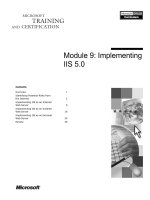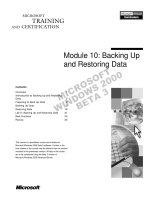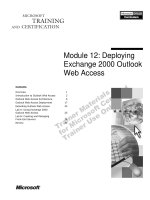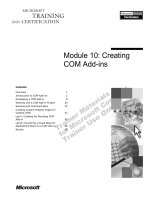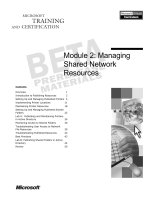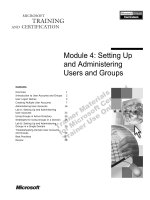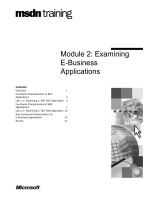Tài liệu Module 12: Operators, Delegates, and Events doc
Bạn đang xem bản rút gọn của tài liệu. Xem và tải ngay bản đầy đủ của tài liệu tại đây (1006.48 KB, 74 trang )
Contents
Overview 1
Introduction to Operators 2
Operator Overloading 6
Lab 12.1: Defining Operators 19
Creating and Using Delegates 37
Defining and Using Events 47
Demonstration: Handling Events 53
Lab 12.2: Defining and Using Events 54
Review 63
Course Evaluation 65
Module 12: Operators,
Delegates, and Events
Information in this document, including URL and other Internet Web site references, is subject to
change without notice. Unless otherwise noted, the example companies, organizations, products,
domain names, e-mail addresses, logos, people, places, and events depicted herein are fictitious,
and no association with any real company, organization, product, domain name, e-mail address,
logo, person, places or events is intended or should be inferred. Complying with all applicable
copyright laws is the responsibility of the user. Without limiting the rights under copyright, no
part of this document may be reproduced, stored in or introduced into a retrieval system, or
transmitted in any form or by any means (electronic, mechanical, photocopying, recording, or
otherwise), or for any purpose, without the express written permission of Microsoft Corporation.
Microsoft may have patents, patent applications, trademarks, copyrights, or other intellectual
property rights covering subject matter in this document. Except as expressly provided in any
written license agreement from Microsoft, the furnishing of this document does not give you any
license to these patents, trademarks, copyrights, or other intellectual property.
2001−2002 Microsoft Corporation. All rights reserved.
Microsoft, MS-DOS, Windows, Windows NT, ActiveX, BizTalk, IntelliSense, JScript, MSDN,
PowerPoint, SQL Server, Visual Basic, Visual C++, Visual C#, Visual J#, Visual Studio, and
Win32 are either registered trademarks or trademarks of Microsoft Corporation in the U.S.A.
and/or other countries.
The names of actual companies and products mentioned herein may be the trademarks of their
respective owners.
Module 12: Operators, Delegates, and Events iii
Instructor Notes
This module covers three areas of useful functionality that may be implemented
in a class; namely, operators, delegates, and events.
After completing this module, students will be able to:
Use operators to manipulate the types and classes supplied with the
Microsoft
® .NET Framework.
Use delegates to decouple a method call from its implementation.
Add event specifications to a class to allow subscribing classes to be
notified of changes in object state.
Materials and Preparation
This section provides the materials and preparation tasks that you need to teach
this module.
Required Materials
To teach this module, you need the following materials:
Microsoft PowerPoint® file 2124C_12.ppt
Module 12, “Operators, Delegates, and Events”
Lab 12.1, Defining Operators
Lab 12.2, Defining and Using Events
Preparation Tasks
To prepare for this module, you should:
Read all of the materials for this module.
Complete the labs.
Read the instructor notes and margin notes for the module.
Practice the Handling Events demonstration. The StockMarket project is in
the install folder\DemoCode\Mod12\StockMarket folder.
Presentation:
60 Minutes
Labs:
60 Minutes
iv Module 12: Operators, Delegates, and Events
Demonstration
This section provides demonstration procedures that will not fit in the margin
notes or are not appropriate for the student notes.
Handling Events
To explain the scenario
1. A model of part of a stock market and two stock brokers has been written as
a Microsoft Visual C#
™
project called StockMarket.
2. When executed, the program creates two stock brokers (Honest John and
Shady Fred) and displays a form allowing the user to create stocks and edit
stock prices.
3. When prices rise and fall, RisingStock and CrashingStock events may be
generated.
4. Honest John subscribes to the RisingStock and CrashingStock events.
5. Shady Fred only subscribes to the RisingStock event.
To explain the code
1. Display the Stock class to show how events are published and raised.
Identify the following items:
a. The CrashingStock and RisingStock events.
b. The StockHandlerEvent delegate.
c. The AddOnCrashingStock and RemoveOnCrashingStock methods.
These are the public methods that objects can use to subscribe to, or
unsubscribe from, the crashingStock event.
d. The AddOnRisingStock and RemoveOnRisingStock methods. These
are the public methods that objects can use to subscribe to, or
unsubscribe from, the RisingStock event.
e. The OnCrashingStock and OnRisingStock methods, which raise the
events.
f. The setPrice method, which calls OnCrashingStock and
OnRisingStock.
2. Display the StockBroker class to show how events are handled when
raised. Identify the following items:
a. The StockCrashing method. This method handles the CrashingStock
event.
b. The StockRising method. This method handles the RisingStock event.
3. Display the StockMarketForm class to show how to subscribe to the
events. Identify the following items:
a. The Main method, which creates the two StockBroker objects (Honest
John and Shady Fred).
b. The cmdNew_Click method, which is executed when a new stock is
added to the market. This creates three StockEventHandler delegates.
Two delegates are for Honest John, and are tied to the RisingStock and
CrashingStock events. The third delegate is for Shady Fred, who
subscribes only to the RisingStock event.
Module 12: Operators, Delegates, and Events v
To demonstrate the application
1. Compile and execute the program.
2. The price form will be displayed. Add the following stock item:
• Ticker: ABCD
• Price: 200
• Threshold: 50
3. Click New. A dialog box will appear confirming the addition of the new
stock.
4. Add another stock item:
• Ticker: WXYZ
• Price: 100
• Threshold: 30
5. Click New. A dialog box will appear confirming the addition of the new
stock.
6. In the Ticker field, enter ABCD, and then click Find. The data for the
ABCD item will appear.
7. Change the price to 204, and then click Change. A dialog box will appear
confirming the price change.
8. Change the price again, to 220, and then click Change. The BUY BUY
BUY dialog boxes of Honest John and Shady Fred will appear when the
RisingStock event is raised. Acknowledge them both.
9. In the Ticker field, enter WXYZ, and then click Find. The data for the
WXYZ item will appear.
10. Change the price to 28, and then click Change. Only Honest John’s SELL
SELL SELL dialog box will appear. (The CrashingStock event was raised,
and only Honest John, not Shady Fred, subscribes to this event.)
vi Module 12: Operators, Delegates, and Events
Module Strategy
Use the following strategy to present this module:
Introduction to Operators
Begin with an explanation of the similarities and differences between
operators and methods. Explain to C++ developers that all operators are
public static methods. On the other hand, the related methods such as
ToString and Equals are instance methods. Then, after a brief discussion of
predefined C# operators, explain how data conversion operators can be used
for implicit and explicit conversion. Take a little time to explain the
difference between an explicit conversion that uses a cast and an implicit
conversion, and to explain the rationale for defining a conversion as either
explicit or implicit. Discuss issues such as whether an exception can be
raised and whether the conversion will always work without losing
information. Take a little time to describe the syntax of the conversion
operators, because this topic has some subtleties.
Operator Overloading
Begin by discussing how to define operators for manipulating classes and
structs and by introducing the concept of operator overloading. Explain that
many C# operators cannot be overridden. Having introduced the basics of
operator overloading in the first topic, explain how to overload relational
operators. Explain that relational operators are always overloaded in pairs.
Also, describe how the Equals method that the class inherits must be
overridden to ensure consistency when two objects of the class are
compared. Then discuss how to overload logical operators indirectly by
evaluating them in terms of operators that can be overloaded. The third set
of operators to be discussed from the overloading perspective is conversion
operators. Provide examples of data conversion operators that you can
define and point out that the class overrides the inherited ToString method.
In the last topic in this section, describe how to further overload operators to
provide alternative implementations that take different types as parameters.
The Time class used for many of the examples in these sections is available
in a Microsoft Visual Studio
® project in the install folder\DemoCode\Time
folder.
The lab for this section asks students to define operators for bank accounts
created in earlier labs, and for a new class of object: rational numbers. You
should explain what a rational number is if students do not know.
Creating and Using Delegates
Delegates are covered as a lead-in to events. To provide motivation for
defining and using delegates, the section uses a case study about a power
station attached to a nuclear reactor. Explain the scenario clearly, discussing
the problem and two possible solutions. Then discuss how the second
solution is more feasible than the first, and discuss its implementation
details. Explain the procedure for defining and creating delegates, and then
discuss how to use them to call methods.
Ensure that students understand how delegates work before discussing
events.
Module 12: Operators, Delegates, and Events vii
Defining and Using Events
Spend some time explaining event handling in C#. Explain the roles played
by publishers and subscribers. Then explain how an event is defined and
how objects can subscribe to it. Also, explain how a subscriber is notified
when an event occurs. Stress the multicast nature of events. It will be useful
to explain each step in the sequence of how an event is published,
subscribed to, and raised. Next, discuss how to pass parameters to methods
when using events. Explain that they should be wrapped in a single class.
An object can subscribe to more than one event from different publishers, so
describe how to pass information about the publisher that raised the event.
Then discuss the importance of providing the AddOnEvent and
RemoveOnEvent methods to subscribe to and unsubscribe from an event.
Also, discuss adding an OnEvent method to raise the event, and encasing
any parameters in an EventArgs object.
Demonstrate how events can be used to communicate information between
objects, and describe how event notification works in C#.
Module 12: Operators, Delegates, and Events 1
Overview
Introduction to Operators
Operator Overloading
Creating and Using Delegates
Defining and Using Events
*****************************
ILLEGAL FOR NON-TRAINER USE******************************
This module covers three areas of useful functionality: operators, delegates, and
events.
Operators are the basic components of a language. You use operators to
perform manipulations and comparisons between variables that may be logical,
relational, or conditional in nature.
Delegates specify a contract between an object that issues calls to a function
and an object that implements the called function.
Events provide the way for a class to notify its clients when a change occurs in
the state of any of its objects.
After completing this module, you will be able to:
Define operators, to make a class or struct easier to use.
Use delegates to decouple a method call from a method implementation.
Add event specifications to a class to allow subscribing classes to be
notified of changes in object state.
Topic Objective
To provide an overview of
the module topics and
objectives.
Lead-in
In this module, you will learn
how to define operators, use
delegates, and add events.
2 Module 12: Operators, Delegates, and Events
Introduction to Operators
Operators and Methods
Predefined C# Operators
*****************************
ILLEGAL FOR NON-TRAINER USE******************************
Operators are different from methods. They have special requirements that
enable them to function as expected. C# has a number of predefined operators
that you can use to manipulate the types and classes supplied with the
Microsoft
® .NET Framework.
After completing this lesson, you will be able to:
Identify why C#, like most languages, has operators.
Define operators, to make a class or struct easier to use.
Topic Objective
To provide an overview of
the topics covered in this
section.
Lead-in
C# has a number of
predefined operators that
perform well-defined
functions on the supplied
.NET Framework classes
and types.
Module 12: Operators, Delegates, and Events 3
Operators and Methods
Using methods
Reduces clarity
Increases risk of errors, both syntactic and semantic
Using operators
Makes expressions clear
myIntVar1 = Int.Add(myIntVar2,
Int.Add(Int.Add(myIntVar3,
myIntVar4), 33));
myIntVar1 = Int.Add(myIntVar2,
Int.Add(Int.Add(myIntVar3,
myIntVar4), 33));
myIntVar1 = myIntVar2 + myIntVar3 + myIntVar4 + 33;
myIntVar1 = myIntVar2 + myIntVar3 + myIntVar4 + 33;
*****************************
ILLEGAL FOR NON-TRAINER USE******************************
The purpose of operators is to make expressions clear and easy to understand. It
would be possible to have a language with no operators, relying instead on
well-defined methods, but this would most likely have an adverse affect on the
clarity of the language.
Using Methods
For example, suppose the arithmetic addition operator was not present, and the
language instead provided an Add method of the Int class that took parameters
and returned a result. Then, to add two variables, you would write code similar
to the following:
myIntVar1 = Int.Add(myIntVar2, myIntVar3);
myIntvar2 = Int.Add(myIntVar2, 1);
Using Operators
By using the arithmetic addition operator, you can write the more concise lines
of code that follow:
myIntVar1 = myIntVar2 + myIntVar3;
myIntVar2 = myIntVar2 + 1;
Code would become almost indecipherable if you were to add a series of values
together by using the Add method, as in the following code:
myIntVar1 = Int.Add(myIntVar2, Int.Add(Int.Add(myIntVar3,
myIntVar4), 33));
If you use methods in this way, the likelihood of errors, both syntactic and
semantic, is enormous. Operators are actually implemented as methods by C#,
but their syntax is designed to make them easy to use. The C# compiler and
runtime automatically convert expressions with operators into the correct series
of method calls.
Topic Objective
To compare, and distinguish
between, operators and
methods.
Lead-in
In addition to using method
names that follow strict
rules, operators also have
other requirements.
4 Module 12: Operators, Delegates, and Events
Predefined C# Operators
Operator Categories
Operator Categories
Type informationAssignment
Indirection and addressOverflow exception control
Object creationRelational
Delegate concatenation and
removal
Shift
ConditionalIncrement and decrement
CastString concatenation
IndexingLogical (Boolean
and bitwise)
Member accessArithmetic
*****************************
ILLEGAL FOR NON-TRAINER USE******************************
The C# language provides a large set of predefined operators. Following is the
complete list.
Operator category Operators
Arithmetic +, -, *, /, %
Logical (Boolean and bitwise) &, |, ^, !, ~, &&, ||, true, false
String concatenation +
Increment and decrement ++,
Shift <<, >>
Relational ==, !=, <, >, <=, >=
Assignment =, +=, -=, *=, /=, %=, &=, |=, <<=, >>=
Member access .
Indexing [ ]
Cast ( )
Conditional ? :
Delegate concatenation and removal +, -
Object creation new
Type information is, sizeof, typeof
Overflow exception control checked, unchecked
Indirection and address *, ->, [ ], &
Topic Objective
To present the operators
defined by the C# language.
Lead-in
The C# language defines a
number of categories of
operators.
Module 12: Operators, Delegates, and Events 5
You use operators for building expressions. The function of most operators is
well understood. For example, the addition operator (+) in the expression
10 + 5 will perform arithmetic addition, and in this example the expression
will yield the value of 15.
Some of the operators may not be as familiar as others, and some are defined as
keywords rather than symbols, but their functionality with the data types and
classes supplied with the .NET Framework is completely defined.
Operators with Multiple Definitions
A confusing aspect of operators is that the same symbol may have several
different meanings. The + in the expression
10 + 5 is clearly the arithmetic
addition operator. You can determine the meaning by the context in which it is
used—no other meaning of + makes sense.
However, the following example uses the + operator to concatenate strings:
"Adam " + "Barr"
It is the function of the parser, when the program is compiled, to determine the
meaning of an operator in any given context.
6 Module 12: Operators, Delegates, and Events
Operator Overloading
Introduction to Operator Overloading
Overloading Relational Operators
Overloading Logical Operators
Overloading Conversion Operators
Overloading Operators Multiple Times
Quiz: Spot the Bugs
*****************************
ILLEGAL FOR NON-TRAINER USE******************************
Many predefined operators in C# perform well-defined functions on classes and
other data types. This clear definition widens the scope of expression for the
user. You can redefine some of the operators provided by C# and use them as
operators that work only with classes and structs that you have defined. In a
sense, this is the same as defining your own operators. This process is known as
operator overloading.
Not all predefined C# operators can be overloaded. The unary arithmetic and
logic operators can be overloaded freely, as can the binary arithmetic operators.
The assignment operators cannot be overloaded directly, but they are all
evaluated using the arithmetic, logical, and shift operators, which in turn can be
overloaded.
After completing this lesson, you will be able to:
Overload relational, logical, and conversion operators.
Overload an operator multiple times.
Topic Objective
To provide an overview of
the topics covered in this
section.
Lead-in
You can change the way in
which C# interprets some
operators when they are
used on your classes.
Module 12: Operators, Delegates, and Events 7
Introduction to Operator Overloading
Operator overloading
Define your own operators only when appropriate
Operator syntax
Operatorop, where op is the operator being overloaded
Example
public static Time operator+(Time t1, Time t2)
{
int newHours = t1.hours + t2.hours;
int newMinutes = t1.minutes + t2.minutes;
return new Time(newHours, newMinutes);
}
public static Time operator+(Time t1, Time t2)
{
int newHours = t1.hours + t2.hours;
int newMinutes = t1.minutes + t2.minutes;
return new Time(newHours, newMinutes);
}
*****************************
ILLEGAL FOR NON-TRAINER USE******************************
Though operators make expressions simpler, you should only define operators
when it makes sense to do so. Operators should only be overloaded when the
class or struct is a piece of data (like a number), and will be used in that way.
An operator should always be unambiguous in usage; there should be only one
possible interpretation of what it means. For example, you should not define an
increment operator (++) on an Employee class (
emp1++;) because the
semantics of such an operation on an Employee are not clear. What does it
actually mean to “increment an employee”? Would you be likely to use this as
part of a larger expression? If by increment you mean “give the employee a
promotion,” define a Promote method instead (
emp1.Promote();).
Syntax for Overloading Operators
All operators are public static methods and their names follow a particular
pattern. All operators are called operatorop, where op specifies exactly which
operator is being overloaded. For example, the method for overloading the
addition operator is operator+.
The parameters that the operator takes and the types of parameters it returns
must be well defined. All arithmetic operators return an instance of the class
and manipulate objects of the class.
Topic Objective
To describe how to define
operators for classes.
Lead-in
How do you go about
defining your own
operators?
Delivery Tip
It is important to stress to
C++ developers that all
operators in C# are static
methods. The model used
by the C# compiler to
synthesize method calls
from operators is somewhat
simpler than the C++
equivalent, but as a
consequence it is easier to
understand and less error
prone.
8 Module 12: Operators, Delegates, and Events
Example
As an example, consider the Time struct shown in the following code. A Time
value consists of two parts: a number of hours and a number of minutes. The
code in bold shows how to implement the binary addition operator (+) for
adding two Times together.
public struct Time
{
public Time(int minutes) : this(0, minutes)
{
}
public Time(int hours, int minutes)
{
this.hours = hours;
this.minutes = minutes;
Normalize( );
}
// Arithmetic
public static Time operator+(Time lhs, Time rhs)
{
return new Time(lhs.hours + rhs.hours,
lhs.minutes + rhs.minutes
);
}
public static Time operator-(Time lhs, Time rhs)
{
}
// Helper methods
private void Normalize( )
{
if (hours < 0 || minutes < 0) {
throw new ArgumentException("Time too small");
}
hours += (minutes / 60);
minutes %= 60;
}
private int TotalMinutes( )
{
return hours * 60 + minutes;
}
private int hours;
private int minutes;
}
Module 12: Operators, Delegates, and Events 9
Overloading Relational Operators
Relational operators must be paired
< and >
<= and >=
== and !=
Override the Equals method if overloading == and !=
Override the GetHashCode method if overriding equals
method
*****************************
ILLEGAL FOR NON-TRAINER USE******************************
You must overload the relational or comparison operators in pairs. Each
relational operator must be defined with its logical antonym. This means that if
you overload <, you must also overload >, and vice versa. Similarly, != must be
overloaded with ==, and <= must be overloaded with >=.
For consistency, create a Compare method first and define all the
relational operators by using Compare. The code example on the following
page shows you how to do this.
Overriding the Equals Method
If you overload == and !=, you should also override the Equals virtual method
that your class inherits from Object. This is to ensure consistency when two
objects of this class are compared, whether by == or the Equals method, so that
a situation in which == returns true and the Equals method returns false is
avoided.
Overriding the GetHashCode Method
The GetHashCode method (also inherited from Object) is used to identify an
instance of your class if it is stored in a hash table. Two instances of the same
class for which Equals returns true should also hash to the same integer value.
By default, this is not the case. Therefore, if you override the Equals method,
you should also override the GetHashCode method.
Topic Objective
To describe how to overload
the relational operators.
Lead-in
There are rules and
guidelines for redefining
relational operators.
Ti
p
10 Module 12: Operators, Delegates, and Events
Example
The following code shows how to implement the relational operators, the
Equals method, and the GetHashCode method for the Time struct:
public struct Time
{
// Equality
public static bool operator==(Time lhs, Time rhs)
{
return lhs.Compare(rhs) == 0;
}
public static bool operator!=(Time lhs, Time rhs)
{
return lhs.Compare(rhs) != 0;
}
// Relational
public static bool operator<(Time lhs, Time rhs)
{
return lhs.Compare(rhs) < 0;
}
public static bool operator>(Time lhs, Time rhs)
{
return lhs.Compare(rhs) > 0;
}
public static bool operator<=(Time lhs, Time rhs)
{
return lhs.Compare(rhs) <= 0;
}
public static bool operator>=(Time lhs, Time rhs)
{
return lhs.Compare(rhs) >= 0;
}
Code continued on following page.
Delivery Tip
Point out that == and != are
based upon the Equals
method, how the < operator
works, and how the
remaining relational
operators use < and == to
guarantee consistency.
Module 12: Operators, Delegates, and Events 11
// Inherited virtual methods (from Object)
public override bool Equals(object obj)
{
return obj is Time && Compare((Time)obj) == 0;
}
public override int GetHashCode( )
{
return TotalMinutes( );
}
private int Compare(Time other)
{
int lhs = TotalMinutes( );
int rhs = other.TotalMinutes( );
int result;
if (lhs < rhs)
result = -1;
else if (lhs > rhs)
result = +1;
else
result = 0;
return result;
}
}
12 Module 12: Operators, Delegates, and Events
Overloading Logical Operators
Operators && and || cannot be overloaded directly
They are evaluated in terms of &, |, true, and false,
which can be overloaded
x && y is evaluated as T.false(x) ? x : T.&(x, y)
x || y is evaluated as T.true(x) ? x : T.|(x, y)
*****************************
ILLEGAL FOR NON-TRAINER USE******************************
You cannot overload the logical operators && and || directly. However, they
are evaluated in terms of the &, |, true, and false operators, which you can
overload.
If variables x and y are both of type T, the logical operators are evaluated as
follows:
x && y is evaluated as T.false(x) ? x : T.&(x, y)
This expression translates as “if x is false as defined by the false operator of
T, the result is x; otherwise it is the result of using the & operator of T over
x and y.”
x || y is evaluated as T.true(x) ? x : T.|(x, y)
This expression means “if x is true as defined by the true operator of T, the
result is x; otherwise it is the result of using the | operator of T over
x and y.”
Topic Objective
To describe how to overload
the logical operators.
Lead-in
Although you cannot
overload the && and ||
operators directly, you can
overload them indirectly if
you understand how they
are evaluated.
Delivery Tip
These operators are shown
for completeness only.
Students are not likely to
need to change how && and
|| are evaluated very often.
Module 12: Operators, Delegates, and Events 13
Overloading Conversion Operators
Overloaded conversion operators
If a class defines a string conversion operator
The class should override ToString
public static explicit operator Time (float hours)
{ }
public static explicit operator float (Time t1)
{ }
public static implicit operator string (Time t1)
{ }
public static explicit operator Time (float hours)
{ }
public static explicit operator float (Time t1)
{ }
public static implicit operator string (Time t1)
{ }
*****************************
ILLEGAL FOR NON-TRAINER USE******************************
You can define implicit and explicit conversion operators for your own classes
and create programmer-defined cast operators that can be used to convert data
from one type to another. Some examples of overloaded conversion operators
are:
explicit operator Time (int minutes)
This operator converts an int into a Time. It is explicit because not all ints
can be converted; a negative argument results in an exception being thrown.
explicit operator Time (float minutes)
This operator converts a float into a Time. Again, it is explicit because a
negative parameter causes an exception to be thrown.
implicit operator int (Time t1)
This operator converts a Time into an int. It is implicit because all Time
values can safely be converted to int.
explicit operator float (Time t1)
This operator converts a Time into a float. In this case the operator is
explicit because, although all Times can be converted to float, the floating-
point representation of some values may not be exact. (You always take this
risk with computations involving floating-point values.)
implicit operator string (Time t1)
This operator converts a Time into a string. This is also implicit because
there is no danger of losing any information in the conversion.
Overriding the ToString Method
Design guidelines recommend that, for consistency, if a class has a string
conversion operator, it should override the ToString method, which should
perform the same function. Many classes and methods in the System
namespace – Console.WriteLine for example – use ToString to create a
printable version of an object.
Topic Objective
To show how to create
methods that will convert
data of one type into
another type.
Lead-in
You can define how to
convert data of various
types into instances of your
class, and vice versa.
14 Module 12: Operators, Delegates, and Events
Example
The following code shows how to implement the conversion operators. It also
shows one way to implement the ToString method. Note how the Time struct
overrides ToString, which is inherited from Object.
public struct Time
{
// Conversion operators
public static explicit operator Time (int minutes)
{
return new Time(0, minutes);
}
public static explicit operator Time (float minutes)
{
return new Time(0, (int)minutes);
}
public static implicit operator int (Time t1)
{
return t1.TotalMinutes( );
}
public static explicit operator float (Time t1)
{
return t1.TotalMinutes( );
}
public static implicit operator string (Time t1)
{
return t1.ToString( );
}
// Inherited virtual methods (from Object)
public override string ToString( )
{
return String.Format("{0}:{1:00}", hours, minutes);
}
}
If a conversion operator could throw an exception or return a partial result,
make it explicit. If a conversion is guaranteed to work without any loss of data,
you can make it implicit.
Tip
Module 12: Operators, Delegates, and Events 15
Overloading Operators Multiple Times
The same operator can be overloaded multiple times
public static Time operator+(Time t1, int hours)
{ }
public static Time operator+(Time t1, float hours)
{ }
public static Time operator-(Time t1, int hours)
{ }
public static Time operator-(Time t1, float hours)
{ }
public static Time operator+(Time t1, int hours)
{ }
public static Time operator+(Time t1, float hours)
{ }
public static Time operator-(Time t1, int hours)
{ }
public static Time operator-(Time t1, float hours)
{ }
*****************************
ILLEGAL FOR NON-TRAINER USE******************************
You can overload the same operator multiple times to provide alternative
implementations that take different types as parameters. At compile time, the
system establishes the method to be called depending upon the types of the
parameters being used to invoke the operator.
Topic Objective
To describe how operators
can be overloaded multiple
times.
Lead-in
You can overload the same
operator many times with
different parameters.
16 Module 12: Operators, Delegates, and Events
Example
The following code shows more examples of how to implement the + and –
operators for the Time struct. Both examples add or subtract a specified
number of hours from the supplied Time:
public struct Time
{
public static Time operator+(Time t1, int hours)
{
return t1 + new Time(hours, 0);
}
public static Time operator+(Time t1, float hours)
{
return t1 + new Time((int)hours, 0);
}
public static Time operator-(Time t1, int hours)
{
return t1 – new Time(hours, 0);
}
public static Time operator-(Time t1, float hours)
{
return t1 – new Time((int)hours, 0);
}
}
Module 12: Operators, Delegates, and Events 17
Quiz: Spot the Bugs
public bool operator != (Time t1, Time t2)
{ }
public bool operator != (Time t1, Time t2)
{ }
1
1
1
public static operator float(Time t1) { }
public static operator float(Time t1) { }
2
2
2
public static Time operator += (Time t1, Time t2)
{ }
public static Time operator += (Time t1, Time t2)
{ }
public static bool Equals(Object obj) { }
public static bool Equals(Object obj) { }
3
3
3
4
4
4
public static int operator implicit(Time t1)
{ }
public static int operator implicit(Time t1)
{ }
5
5
5
*****************************
ILLEGAL FOR NON-TRAINER USE******************************
In this quiz, you can work with a partner to spot the bugs in the code on the
slide. To see the answers to this quiz, turn the page.
Topic Objective
To introduce the quiz.
Lead-in
In this quiz, you can work
with a partner to spot the
bugs in the code on the
slide.
